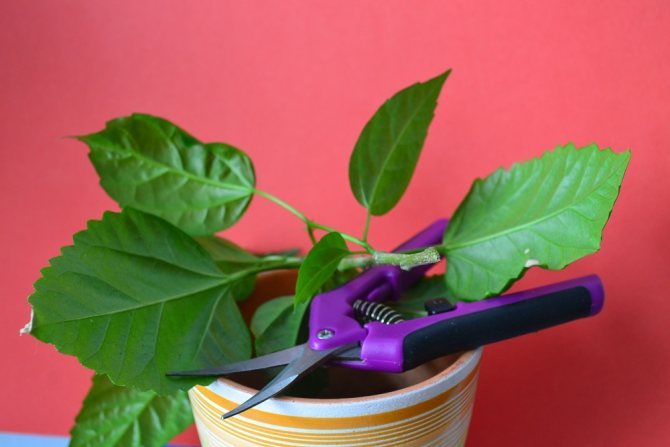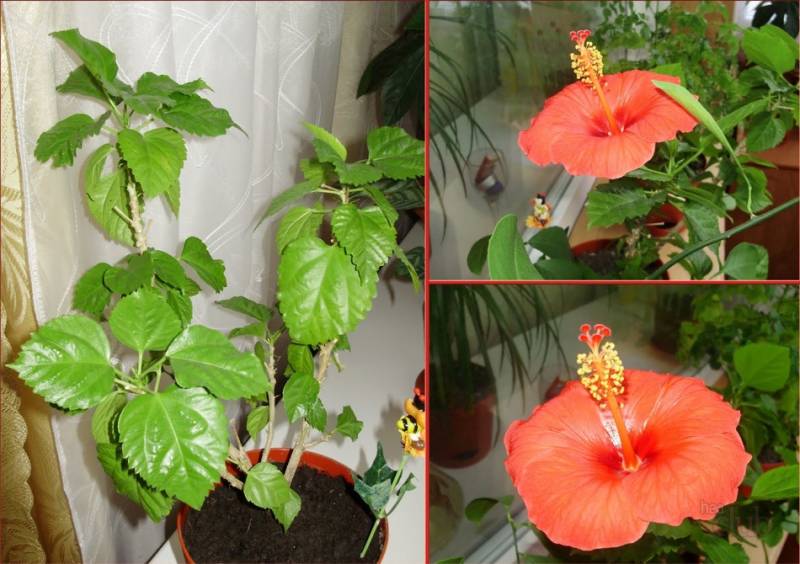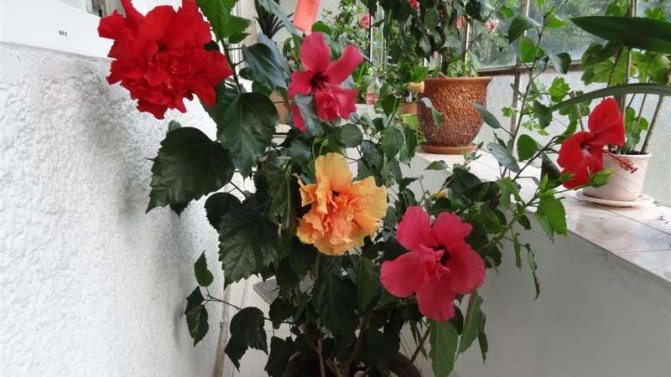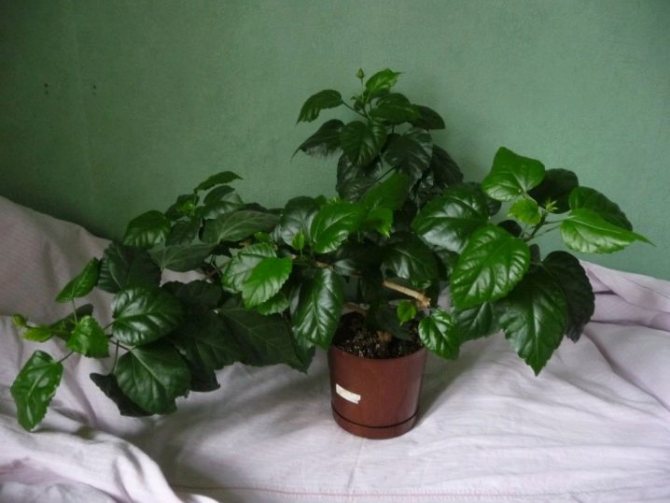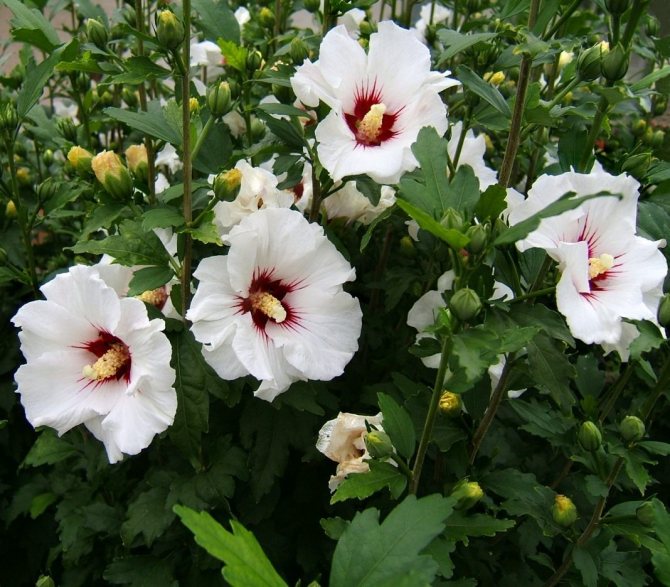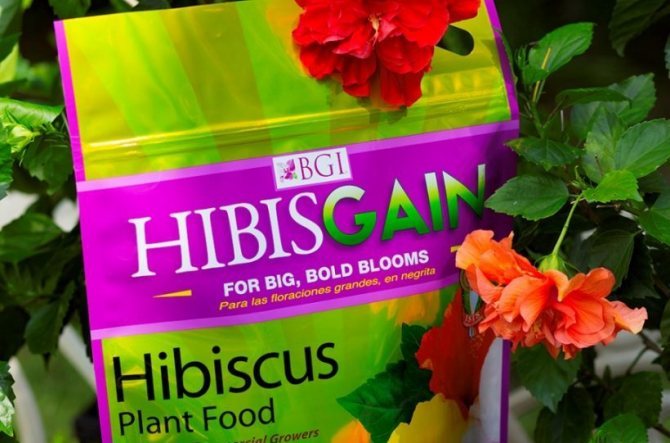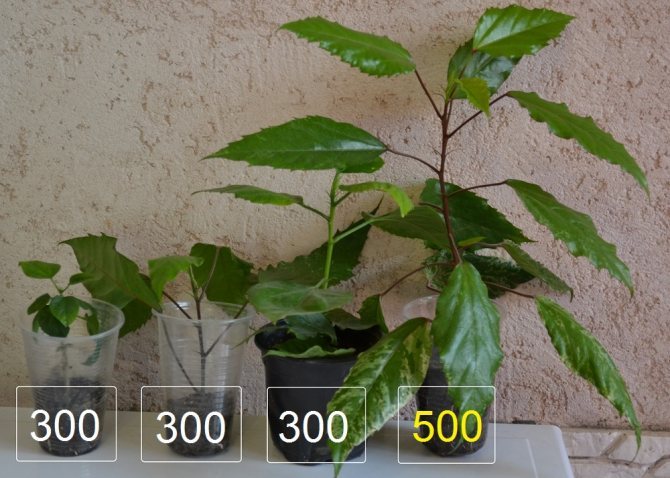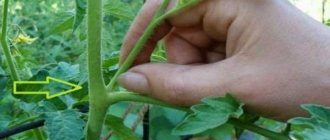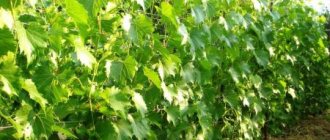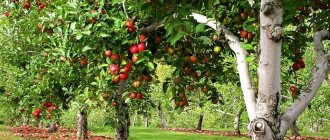Why do they prune?
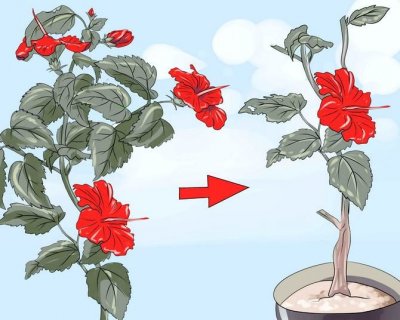
Pruning indoor hibiscus or "Chinese rose", as it is popularly called, is vital. There are a number of reasons for this:
- To get rid of deformed shoots - over time, some become bent, become short and acquire an irregular shape. This needs to be corrected: cut off the curved, in the place of which new ones will grow.
- To shape the plant. The plant is not always able to grow lush "hair" on its own - instead, only old shoots grow. That's when pruning is required. Just do not forget that after this the flower spends all its strength on the growth of new shoots, therefore, either does not bloom at all, or blooms weakly.
- To rejuvenate the plant. Over time, the flower has many old dried branches, which must be urgently disposed of.
- To get rid of sick shoots. In this case, it is called "sanitary" pruning: they remove the affected parts of the plant, capturing healthy parts.
- So that the plant grows well and pleases with abundant flowering. In some cases, carry out pruning flower roots, but this happens extremely rarely - mainly when the root system has grown too large and does not have enough space in the pot. In this case, you must act very carefully - you can damage the roots.
The difference between hibiscus and hibiscus
Garden hibiscus or Chinese rose - species, outdoor cultivation
Hibiscus is a pure hibiscus drink without any additives. It is distinguished by its bright red or burgundy color, sweet-sour aftertaste. Made from Sudanese rose flowers. What is the difference between carcade and hibiscus? The plant itself is called hibiscus, and hibiscus is the part of its flower that is used to make a drink.
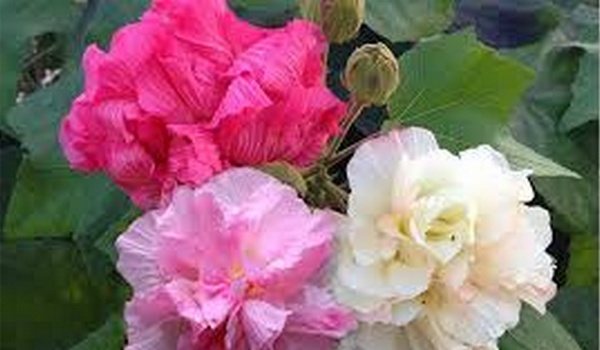

Hibiscus mutable
How to form the crown correctly?


There are two ways to form a hibiscus crown: lush crown and horizontal.
A lush crown must be formed more carefully and more often than a horizontal one. Here who likes more, what is more suitable for the interior, and so on.
One of the benefits of hibiscus is that it allows you to have a lush crown and a tall tree. Cut off regular scissors - the branches of the flower are thin for the secateurs.
It is necessary to cut off the shoots growing parallel to the main branches. Everything dry twigs also need delete.
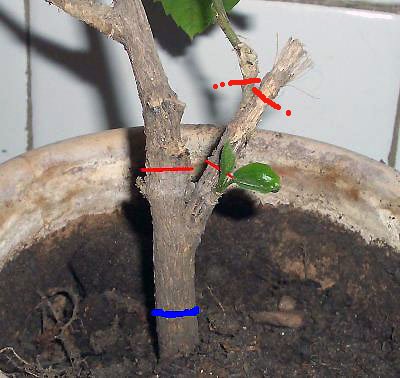

Cut the hibiscus every year in the spring. In the fall, after each flowering, the plant also needs pruning. If this is not done, side shoots will not grow and there will be no new buds and flowers. Moreover, hibiscus flowers appear only on young shoots.
Therefore, in order for it to bloom, you need as much as possible prune it more often. In addition, the crown of the plant will become thicker and more spreading from this.
It is not recommended to prune in summer - this way you will not get flowers.
How to prune indoor hibiscus?
Indoor hibiscus has a lifespan of 20 years. During this time, the flower grows very much, and you cannot do without pruning. Homemade hibiscus (see photo) can be pruned in fall (September-October) and spring (early March). The main thing is that the flower has time to bloom. But in the summer it is impossible to carry out pruning, as the hibiscus may stop blooming.


An indoor flower can have a wide variety of shapes.They choose them based on personal preferences, interior design and other factors.
Step-by-step master class of crown formation:
- All dry shoots must be cut off first. They are no longer viable and only interfere with the flower. It is best to use a sharp garden knife or blade to avoid breaking branches or sawing.
- It is also necessary to remove deformed, damaged and weak branches.
- After all the unnecessary is cut off, it is necessary to carry out a supporting haircut (it is necessary to give the desired shape to the plant).
- Each thin branch is cut to the level of the 3rd bud. And if, after pruning the hibiscus, the crown turned out to be one-sided, then it is necessary to remove all unwanted processes to the base of the flower.
Important! When it comes to sanitary pruning, it is best done in the spring months before flowering. In the case when rejuvenating pruning is carried out, it is necessary to capture not only the branches from the outside, but also the internal ones, removing them by 2/3.
No special care for the hibiscus after pruning is required. The flower tolerates the procedure calmly, and after 2-3 weeks new shoots appear. However, there are times when the hibiscus withers after the procedure. Most often, this is due to a strong cut to a hemp, while the stems remain without leaves. As a rule, such branches are not viable, they dry out, do not form new buds, and the plant begins to wilt.
Also, an incorrectly selected pruning tool can harm the plant. Garden pruners are very rough and will damage the thin branches of the hibiscus. As a result, the flower dies. Therefore, when pruning, you should be very careful.
It will also be useful to pinch the flower. This procedure is carried out in early spring. The pinching takes place as follows:
- The central shoot is tied to a support (you can use a bamboo stick).
- The side branches are trimmed to the fifth petal.
Indoor hibiscus needs annual pruning to flower. If you do not do it, then the side shoots will prevent the formation of new branches and the formation of buds. As a result, flowering can be short-lived and poor.
We also recommend watching a video that explains what mistakes you can make during pruning, and also shows you how to properly prune hibiscus.
How to pinch?
Pinching young shoots will not be harmful to hibiscus. This should be done in early spring. You can pinch everything - it will not hurt them in any way.
You need to pinch hibiscus like this: central shoot tie to the support, and cut off all the side ones, leaving 3-5 leaves. A bamboo stick is most often taken as a support. If you don't have one at hand, you can use a pencil, knitting needle or other handy material that is useful for this role. Due to this procedure, the barrel will become thicker.
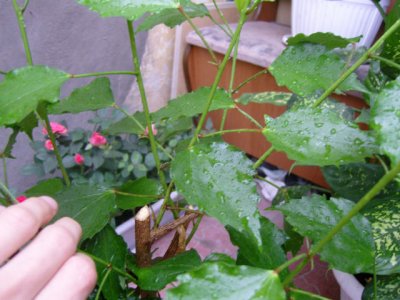

It must be remembered that at this time you need to actively feed the plant with nitrogen. When the flower grows to the desired length, it is necessary to pinch its crown, leaving 5-6 well-developed shoots. This is the future crown - it needs to be cut more often in order to get dense branches.
It is imperative to cut off the so-called "Tops" - shoots that grow parallel to the main trunk. The branches growing inside the crown also need pruning.
So, pruning is required for all plants, and for hibiscus too. She is not only called improve the appearance of the flower, but also has a good effect on him health and condition.
Prune after each flowering in spring and fall. In the fall, you should not carry out this procedure. You need to use ordinary scissors. There are two ways to form the crown of a plant: create a lush crown and a horizontal one. Pinching is also extremely necessary. This will help the young shoots grow faster, which means there will be more buds and flowers.
See how good the Chinese rose is after pruning!
How to plant at home?
Hibiscus is an unpretentious plant, but its transplantation has several subtleties.
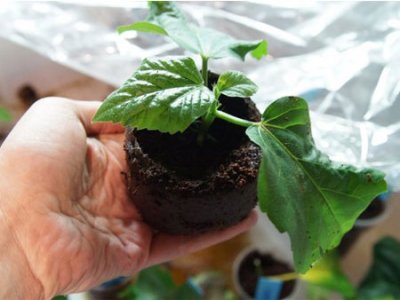

Soil / Ground - What kind of soil is suitable for a tea rose? Cuttings of a Chinese rose are transplanted into loose soil with neutral acidity - it contributes to their rapid root formation. Young plants need nutritious, but not greasy soil.
Adult hibiscus are less demanding on the soil, only 2 conditions must be met - drainage and good looseness... An adult plant is transplanted only when the pot becomes small for it.
Soil composition
For planting cuttings, clean sand or a mixture of one part of sand and one part of peat is used. It is in such a soil for 25-30 days - during this period a stable root system is formed in the plant and it is already transplanted into a pot to form a bush. For a young tea rose, a soil is prepared from the following components:
- 1 part compost or humus;
- 2 pieces of turf;
- 1 part sand.
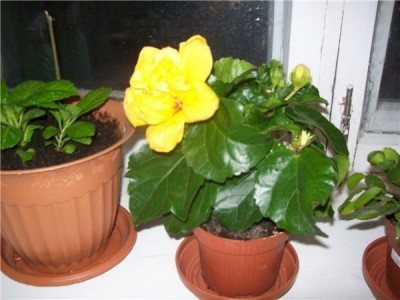

The composition sometimes includes one part of leafy land for added nutrition.
To improve the looseness of the soil, pieces of charcoal and a little peat are added to it. And to accelerate the formation of buds, a small amount of bone meal is included in the soil. Clay shards or expanded clay are used as drainage.
What kind of pot is needed when planting / transplanting?
In order for the plant to grow healthy and strong, the following recommendations must be followed:
- For planting cuttings of a Chinese rose, use a low pot (7-10 cm). Its diameter depends on the number of seedlings. After rooting, each stalk is planted in a separate container up to 10 cm high, with a radius of 4-5 cm.
- The size of the pot for an adult tea rose is chosen very carefully. When the crown of the plant grows extensively, the hibiscus is transplanted into a container one size larger: its diameter and height should be 5-7 cm higher than the size of the previous dish.
- The materials used for the pots should also be chosen carefully. The Chinese rose grows well in ceramic pots and wooden pots. In plastic containers, the roots of the plant will overheat. Immediately after buying the pots, they are soaked in boiling water for 2-3 hours. Used containers are washed with running water (without the use of special cleaning agents).


The best season for planting and transplanting hibiscus is Spring... At this time of the year, the plant is gaining strength and growing. The best reproduction period for hibiscus cuttings is from March to May: in the next two months of spring, the plant will take root and have time to gain color (read about the reproduction of hibiscus in our material). The planting of young, rooted cuttings that have formed shoots is performed in May. The transshipment of an adult tea rose can be done in any month of spring.
Useful video
Learn more about how to do this in the video:
https://youtu.be/BTr45-A3W7U
If you find an error, please select a piece of text and press Ctrl + Enter.
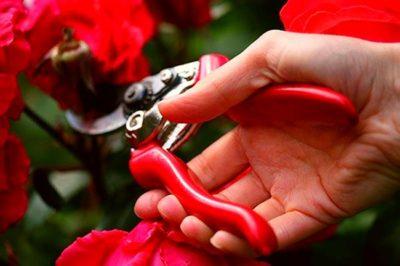

The Chinese Rose plant is very large, so not everyone decides to settle it in their apartment. But there is a very good and simple way to limit the size of the flower to the necessary - this is pruning. With its help, you can easily adjust the parameters you want. This extraordinary plant is able to surprise and delight with its flowering for a very long time. Consider when and how to properly carry out this procedure for a houseplant, whether it can be done in winter and at other times of the year.
The most important thing is wintering
The wintering strategy for garden hibiscus depends on their winter hardiness:
- Herbaceous hybrid and bushy Syrian hibiscus do not need strong shelter; with age, they can be covered at all with only a minimal hitch or not at all.
- Low-hardy old Syrian hibiscus and capricious varieties not from your region in the garden can winter only at a very mature age and with strong shelter, but it is better to grow them as annual plants or take them indoors for the winter.
- Do the same if you are not sure about the frost resistance and origin of the plant (or have acquired a very beautiful, but initially capricious variety). It is better to dig the hibiscus together with a large earthen clod, move it to a container and store it in a cold, but frost-free and bright room.
- Tubular and indoor hibiscus are taken into the house with a short adaptation period as soon as the threat of night frosts appears. They are best grown during the cold season as indoor plants or placed in a frost-free room with access to light.
The preparation of herbaceous hibiscus differs from the preparation of bushy and tree-like plants: they are cut to a height of about 10-15 cm above the soil level and spud to the full height with foliage or mulched with dry light soil. This will be enough for wintering.
A distinctive feature of tree and bush hibiscus is the ability to become more and more frost-resistant with age. With good care and cultivation without transplants, hibiscus will become completely winter-hardy after a few years, and old bushes will not suffer at all from even the most severe frosts. But keeping plants to maturity is difficult and requires constant vigilance. Hibiscuses are especially sensitive in the first year after planting, but even before a 4-5-year return, you should not take risks and leave them without shelter.
On a note. Hibiscuses, especially hybrid ones, produce leaf buds and show signs of growth very late, most often only in May, and sometimes wait for summer. The absence of leaves should not be taken as a signal that the plant did not survive the winter: do not worry until June and only then draw conclusions. Moreover, the younger the plant, the later it will wake up.
Features of holding at different times of the year
In the spring
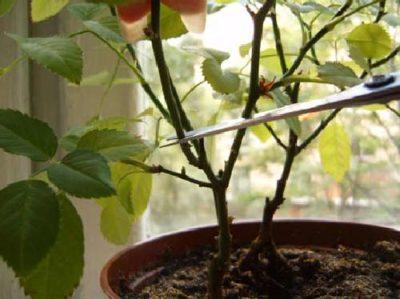

The flower of the Chinese Rose is formed at the very top of the shoot (young), it turns out, the more our plant begins to bush, the more magnificently it will bloom... Therefore, you do not need to be afraid to remove the excess, the bush after pruning will release many new shoots and twigs, at the ends of which buds will form.
However, there are still some limitations - it is undesirable to cut more than 2/3 of the total plant volume. It is important to decide on the desired shape of the bush before starting the procedure, and not in the process, in order to avoid mistakes. The cut should be above the outward-facing bud, and the cut should be at a 45 degree angle.
In the spring, a complete pruning of the bush is usually carried out, that is, all branches are shortened by 2/3. It is imperative to remove all "tops" growing parallel to the main stem and branches that grow inside the crown.
In autumn
It is carried out after the flowering is completely completed, you need to shorten all the branches that have bloomed. Usually, formative pruning is carried out in the fall, that is, 1/3 of the length of the branches. If you are growing a small plant and do not want it to grow up, then you will have to shorten the entire crown - all branches.
All broken and diseased branches are removed (if any), it is also necessary to remove tops if they reappear. There is also such an option - in the fall, you can cut the plant to a hemp (leave approximately 5 cm) and remove it in a cool place in the shade, and in the spring it will begin to grow rapidly.
Time of year for anti-aging treatments
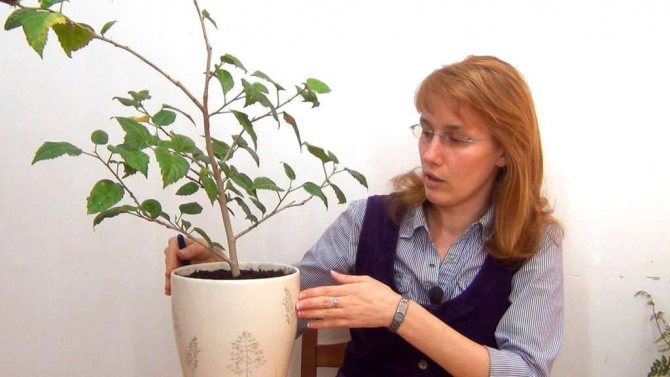

Gardeners always argue about when it is best to prune indoor hibiscus - in the fall or spring. But they act at their own discretion, in accordance with the acquired personal experience. Spring is the growing season, so work needs to be done before the hibiscus begins to grow, since at the end of February the plant wakes up and gives the first shoots.Long shoots are shortened to stimulate branching. If the bushes are rejuvenated in late spring, for example, in the last days of May, then you can not wait for budding and flowering. The most favorable time for pruning homemade hibiscus is February. Those buds that slept in winter will throw out a couple of leaves, then a twig will grow, on which flowering buds will appear in May.
Can hibiscus be pruned in the fall? Summer and early autumn are the flowering period, which means you need to wait for the rose to stop blooming. In this case, there should be no blossoming buds on those shoots that need to be shortened or removed. After the flowering period, not only dried flowers are removed, but also parts of the stems with internodes and with the presence of leaves.
Pruning old and new plants - is there a difference?
Of course, there is a difference between pruning an old adult plant and a new young one, let's take a closer look.
- Pruning a new plant - a young new bush requires gentle pruning, which is called pinching. Indeed, for such a plant, it is not yet necessary to carry out serious pruning to stimulate the growth of new young shoots. In a young bush, it is necessary to pinch the very tips of all branches above the upper bud and this will be enough.
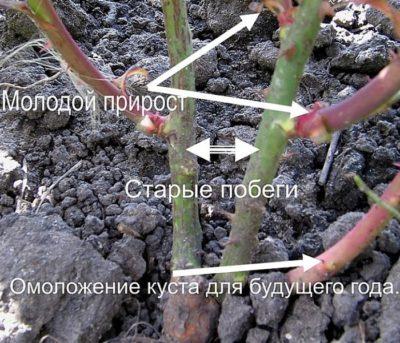

Pruning an old plant - it needs a more radical pruning - or shortening all shoots by 2/3 parts, or in some cases the Chinese Rose is almost completely cut off, leaving a small stump (in the fall). So from such a hemp, one might say, from the roots, a new strong plant grows - such a unique ability is possessed by the Chinese Rose. Thanks to pruning, the old bush undergoes a rejuvenation procedure, a powerful impetus is given for the growth of young shoots and the quality of flowering increases.
Frequency and timing of the procedure
Pruning garden hibiscus should be done annually, and more than once:
- Spring pruning stimulates the growth of new shoots in the plant, which means a luxurious flowering in the summer. It is the pruning of the plant in the spring that determines the decorative effect of the bush. Therefore, it is mandatory.
- At the end of flowering, the plant is pruned again. This is done in the fall, which gives an impetus to the growth of lateral shoots.
- It is categorically impossible to do pruning in winter. Otherwise, in the summer you will not get such a long-awaited flowering.
Step-by-step instruction
For pruning to form a bush:
- To begin with, we prepare the tools: a knife and scissors (always sharp and disinfected) and coal (in powder) for processing the sections.
- We determine for ourselves the desired shape and the approximate height of the bush.
- Then it is required to cut off those shoots that are parallel to the branches, when the central stem is cut (thereby freeing up space for the growth of the lateral ones), then the lateral branches turn into real full-fledged stems.
- Next, you need to periodically prune to maintain the desired shape of all branches.
To make a Chinese rose lush:
- This type of pruning is very simple, absolutely all branches must be shortened (preferably in spring and autumn) by 1/3 of the length above the leaf (or bud) that is turned outward.
- You can also pinch or selectively prune some branches in the summer for better splendor of the plant.
Diseases and pests
- Aphid. Symptoms: yellow spots on the leaves, wilting and dropping of buds. The flower is affected by small and sedentary insects. The parasites are green or black in color, miniature in size 1–5 mm, feed on sap.
- Fight: spray 7 drops of the preparation with actellik on 0.5 l of water. After 7 days, repeat the procedure.
- From folk remedies: dry pepper 100 g, pour water and boil for 1 hour, settle for a day. The mixture is filtered through a sieve and 5 g of the resulting concentrate, 2 g of soap is added to water (0.5 liters) and spraying is done.
- The insect is very small (0.1–0.3 mm) and can be overlooked with the naked eye. The place of his settlement is the underside of the leaf, a favorable environment is dry and warm air.
Chlorosis... Signs of the disease: falling leaves and the appearance of new ones - yellow. The reasons may be: lack of nitrogen and iron. To fix this, you need to water with the addition of iron. Apply nitrogen to the soil in the spring.
It is imperative to fight pests and diseases so as not to infect neighboring specimens.
Possible errors and their prevention


It is worth paying attention to what mistakes cannot be made when pruning a Chinese Rose:
- You cannot do this procedure during flowering, it can greatly weaken the plant. If you only urgently need to remove the diseased branch, then you will have to do it very carefully, without touching others, be sure to then process the cut site.
- You can not cut the flower in winter, at rest, unnecessary processes may start.
- It is forbidden to take poorly sharpened tools and make slices with them categorically - after all, as a result, you will get uneven torn edges, which will not heal well, and the plant will immediately look sloppy.
Disinfection of cutting tools
The use of a dirty cutting tool can quickly lead to infection of the plant with various infections, especially on damp autumn days. The transmission of pathogens such as fungi during the fall months and with dirty cutting tools is more likely to damage your garden hibiscus when pruning. Instruments must be disinfected before each use. There are various disinfection options:
Fire disinfection
The cutting blades of the tool are held over the fire for a few seconds. In this case, care must be taken to create intense contact between the blades and the flame for several seconds. This will be enough to kill bacteria, viruses and fungal spores. The source of the flame can be a gas burner, lighter or burning alcohol.
Alcohol disinfection
Use regular alcohol or isopropyl alcohol to effectively disinfect cutting tools. If you use alcohol, then it must be mixed with distilled water in a ratio of 7: 1. Isopropyl alcohol should be 70% and can be bought at the pharmacy. When using alcohol, cutting tools should be placed in the solution and remain completely submerged in it for at least two minutes. After that, the tools are wiped with a clean cloth, or even better, wait a while for the tool to dry completely.
Chemical disinfection
You don't have to worry about contamination by fungi or bacteria in your hibiscus if you chemically treat the blades of your cutting tool before pruning.
An example of such a means "Dimanin", it is used as a disinfectant against various pathogenic and other microorganisms.You can take a five percent solution and immerse the cutting tool in it for just one minute, all harmful microorganisms will be reliably killed.
Follow-up care
After completing all the manipulations, the Chinese Rose can be sprayed with Epin for easier adaptation. And then we take care of it as usual, we provide the conditions necessary for its successful growth and flowering.
- Watering - when active growth or flowering occurs, then abundant watering is needed so that the soil does not dry out, the top layer only slightly dries out. In cool weather (autumn - winter), watering is not needed so often, but the soil in any case should not dry out, water it about once a week. Only soft, settled water is suitable for irrigation.
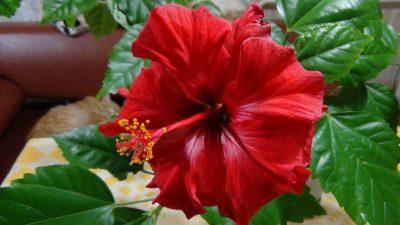

Humidity - you need to maintain air humidity of about 45 - 50%, for this you can put a fountain next to the bush or just a vase of water. It is also necessary to constantly spray the plant, only with soft and warm water, periodically rinse it under the shower, the leaves must be clean from dust.- Top dressing - it is very good to use complex, such as "Rainbow", you need to make approximately once a month, and during flowering 2 times a month.
- Temperature - in summer, the desired temperature for the plant is 20 - 25 degrees, and in winter it is necessary to maintain about 18 - 16 degrees. The Chinese Rose does not like drafts, it is necessary to ventilate the room, an inflow of fresh air is required for the flower, but exclude the ingress of wind (especially cold).
- Lighting - you need good, better on the east window (or west), the light should be diffused, shade from the direct rays of the sun. In the summer, it is very useful to take the flower out to the balcony, in the fresh air.
Watching a video on the topic: "Caring for a Chinese rose at home"
https://youtu.be/OJMeF4vK_Bc
You can find out more about caring for a Chinese rose here.
Landing
Planting hibiscus should be done at the end of the winter period. The seeds must be pre-soaked for 12 hours. You need to plant in a mixture of sand and peat. It is required to create conditions like in a greenhouse, constantly spray and ventilate.
Location and lighting
Hibiscus is a light-loving plant. He needs a warm and sunny location where he starts flowering from March. Hibiscus can grow in the shade, but lack of light affects growth and flowering. In the summer, the plant will benefit greatly from being outdoors. In winter, keep at a temperature of 15 ° C. Compliance with these conditions will affect the increase in the number of buds.
Pot size


The size of the hibiscus pot should match the size of the roots. Also an important condition is the presence of drainage in the flower pot.
The soil
A ready-made soil substrate for ornamental shrubs is best suited. It is loose, waterproof and contains a lot of nutrients. If you prepare the soil yourself, the composition should be as follows: sod land, leafy earth, pine land, humus (only one part), and you should also add peat and sand. Adding charcoal won't hurt either. The acidity should be closer to neutral.
Transfer
For transplanting, you need to take expanded clay, pour it on the bottom of the pot. Pour some earth into the pot. Place the hibiscus together with a lump of earth in a pot. Top up with soil so that the pot is full. To make the hibiscus grow upright, it can be tied to a support. After that, it is necessary to shed the earth well and cover the pot with foil for two days near the roots. This will allow the hibiscus to adapt more easily after the stress experienced during the transplant. Then the film is removed and the flower grows in the usual way. The main thing now is to provide good lighting, constant watering and fresh air.
Fertilizing plants that have just been transplanted is not worth it right away. This is best done after two weeks. It is necessary to carefully monitor the looseness of the soil.
Fertilizers and feeding
Hibiscus need regular fertilization and love it very much. In order for the flowering to be beautiful and bright, as well as for the plant to grow successfully, fertilizing them is simply necessary. It is important to know that this plant does not tolerate phosphorus and loves potassium. In the spring and summer, fertilize up to twice a week; in the fall and winter, fertilize once a week.
What is hibiscus pruning for?
Indoor hibiscus needs pruning, for this plant such a procedure is mandatory. We will find out the reasons why this procedure should be carried out.
After some time, the shoots may deform, become uneven or short. To solve this problem, old shoots are cut off, and new ones with the correct shape grow in their place.
Instead of splendor, only old shoots grow on the bush, as a result the plant has poor greenery. After pruning, the bush begins to develop in full force, gives many new green shoots, and becomes lush. But flowering occurs weakly or it may not exist at all, since at first the plant spends all its energy on renewing greenery. Thus, the flower will have a beautiful lush shape.
This procedure is carried out for the purpose of rejuvenation, after a time, dry shoots appear on the plant, they must be cut off so that new shoots appear.
Pruning can be sanitary, in which case it is necessary to get rid of the affected processes, while removing a little healthy part.
In order for the bush to develop well, and the flowering is abundant, pruning is also performed.
Sometimes the roots of the flower are cut off, this procedure is performed very rarely, in such cases when they have grown too much and do not fit in the pot. This must be done with special care so as not to damage the main branches of the roots.
Herbaceous hibiscus: propagation from seed to a flowerpot
If you have decided on a hibiscus variety, then it's time to prepare the soil or earthen mixture. Many use ready-made soil mixture from stores, if this is not possible, then you can prepare it yourself by mixing garden soil with leaf in equal proportions. The prepared soil must be sieved and poured into small boxes. Now make grooves with a stick and gently pour out the seeds.
We offer you to familiarize yourself with: Cauliflower for the winter - 12 options for photos of recipes for harvesting cauliflower for the winter
Usually such a planting is carried out in winter, so do not leave the boxes on the balcony, it is best to place them near the radiators. The soil will dry out very quickly, so regular watering will be required to slow the drying rate. The boxes can be placed in bags or wrapped in plastic wrap.
When the first shoots appear, be sure to transfer the boxes to a sunny place, otherwise they may die. Once the sprouts are strong, it's time to move them into separate small pots. As it grows, transplant into larger pots, remembering to water after transplanting. When the first bud appears, it must be removed, as the seedling may weaken and die.
You can get a new plant both by cuttings, and by layering, and by dividing bushes, and even by seeds. Success in the reproduction of hibiscus depends primarily on the correct choice of the mother plant: you should not try to remove plants from indoor hibiscus for the garden. If you want a frost-resistant specimen, make sure that the mother plant not only tolerates winters well in your area under cover, but has also adapted so much that it does not require full cover with spruce branches. Use adult, well-adapted hibiscus for reproduction.
The easiest way to propagate hibiscus is by cuttings that can be cut throughout the summer. Young growth is used for reproduction.Cuttings with 2 or 3 internodes are cut and immediately treated with preparations that stimulate growth and rooting. Hibiscus cuttings root well in the heat, at a temperature of about 22-25 degrees in any sandy-peat soil mixture.
Moreover, the whole process takes no more than a month. Immediately after rooting, the cuttings must be transferred to individual containers with fertile soil and grown, watering only with warm water. Grow at least 2 years (and preferably all 2-3) cutted hibiscus as container crops, with cold wintering indoors and as long as possible growing in the garden. And only then transfer them to open soil.
From seeds, perennial hibiscus is grown only through seedlings, while sowing should be very early - from January to the first half of March. They require etching in a growth stimulator, loose soil mixture, high temperatures of about 25-26 degrees Celsius and cover with glass or film. Seedlings should not be touched until 2-3 full-fledged leaves are released, after which they need to be cut into small individual pots.
Separate and separate the lateral strokes only in the herbaceous hibiscus. The procedure is carried out on bushes over 5-6 years old in the spring.
Correct formation of the hibiscus crown
You can form a hibiscus crown in two types, create a lush or horizontal shape.
The crown of a lush appearance is formed much more often in comparison with a horizontal view. The form is chosen independently, who likes what more or suits the design of the room. The main advantage of hibiscus is that it can be grown as a lush bush or a tall flowering tree.
Pruning is carried out using ordinary scissors, the branches of the plant are thin, so the procedure is not difficult. Cut off the shoots located parallel to the main branches, as well as all dried elements.
To give splendor to the plant, a section is cut off by 1/3 of the leaf looking outward. Pruning is performed annually in the spring. This procedure is also carried out in the fall, after active flowering. In the absence of such a procedure, the plant will stop blooming, since flowers appear only on the processes of a young species.
It is best not to prune in the summer, as the bush will not produce flowers.
Reproduction of the Chinese rose, or hibiscus
The propagation of herbaceous hibiscus is carried out in two ways: using cuttings and by growing from seeds.
Propagation by cuttings
To prepare cuttings, young plants with developed shoots and semi-lignified bark are chosen. Shoots are cut diagonally with a sharp knife. The optimal length of the cutting is 15 cm. It must have at least three internodes. The upper part of the cutting is shortened with a straight cut and the lateral leaves are removed. The remaining sheets are cut in half. The lower part of the cutting should be soaked in Epin's solution for a couple of hours.
When is the best time to prune?
Spring and autumn are considered optimal pruning periods. In autumn, you can do this after flowering stops. In the spring, it is very important not to miss the moment, to carry out the procedure before the flower buds open. If you prune at the wrong time and expose young shoots to this, flowering may not occur. New buds are formed only on young shoots. The time of active growth and flowering (from April to September) is absolutely not acceptable for pruning.
The beginning of winter (December) - the transition of the plant to the dormant stage, pruning at this time can provoke the formation of shoots, which is undesirable, since it will weaken the plant preparing for a new flowering. Pruning during flowering is also undesirable. This is an extreme measure, the need for which can be justified by saving the plant from any pests.
Methods for rejuvenation and culture formation
Pruning and shaping hibiscus is carried out by methods:
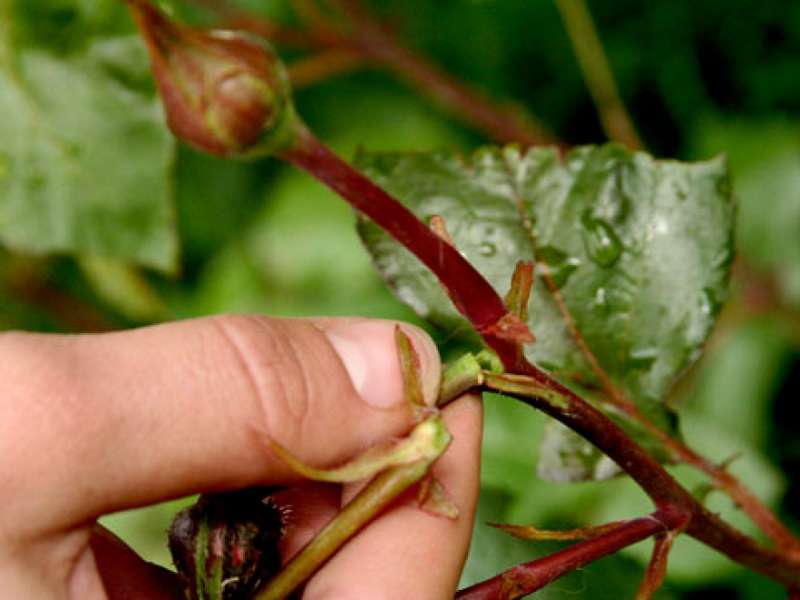

This gentle method stimulates the growth of young plants. In this case, only the tip of the strongest shoot is removed, on which young numerous branches will grow, forming the crown.
Selective or complete pruning of shoots
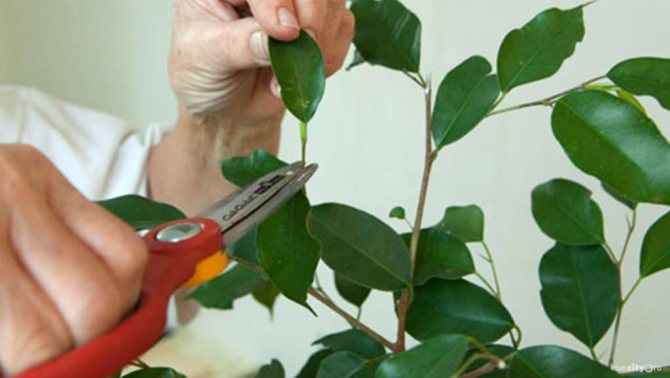

The method is carried out at the beginning of the growing season, it is necessary for the formation of a lush crown of a tree or bush from all sides, when young shoots are released by the plant.
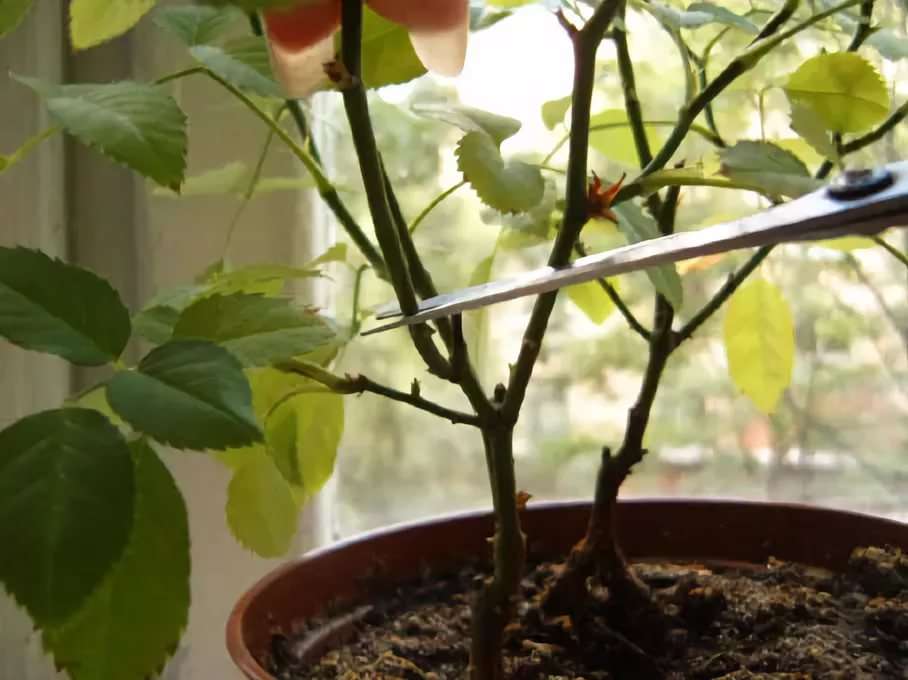

Remove diseased branches, non-viable, with the presence of foci of infection by fungi and pests, as well as dry foliage and frostbitten branches. The branches are shortened to a living lignified part, on which shoots will later grow: new and young.
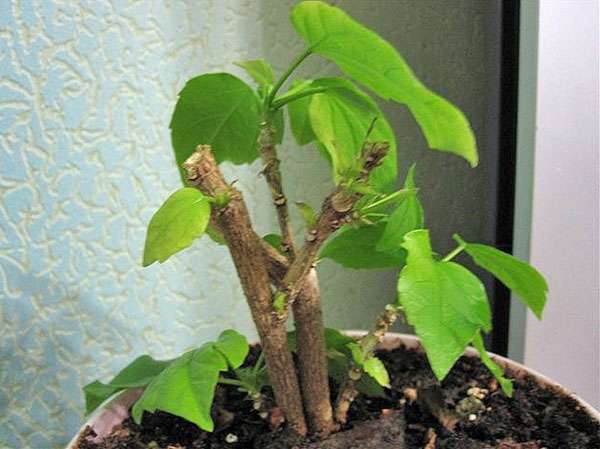

A dying plant is severely pruned, which cannot cope with diseases and pests and does not respond to all resuscitation measures: feeding, watering, lighting, pollination with insecticides, etc. This removes foliage and damaged parts of the plant, leaving viable buds at the base of the roots.
It's important to know. Even with a strong pruning of hibiscus up to the hemp, the stem will quickly recover, it grows overgrown with branches with shoots, on which buds form and bloom.




